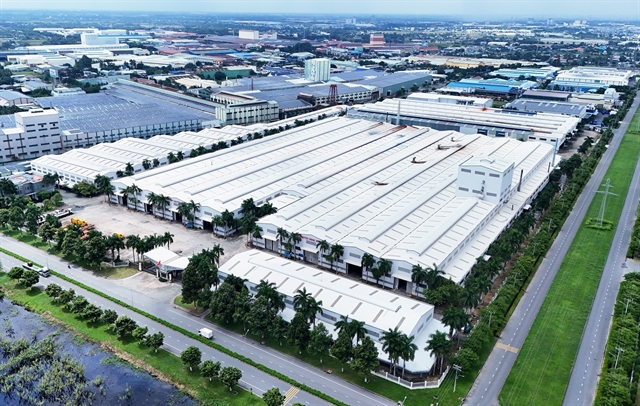 Economy
Economy

The Vietnam Electricity (EVN) announced a significant increase in production for the first six months of 2017, as their total electricity input and output reached 94.9 billion kilowatts, up by 7.23 per cent from the same period in 2016.
 |
| A 220 kV power line is being installed by the National Power Transmission Corporation under Electricity of Vietnam. — VNA/VNS Photo Ngọc Hà |
HÀ NỘI — National power utility Electricity of Vietnam (EVN) says increased production and decreased transmission loss will allow it to meet power needs in the 2017 dry season.
The utility announced on its website a first half production of 94.9 billion kW, a year-on-year increase of 7.23 per cent.
Commercial electricity production increased 8.47 per cent year-on-year to 82.9 billion kW, with domestic supply increasing by 8.78 per cent over last year. The most productive day on June 2 saw a record 628.4 million kW generated at the maximum transmission capacity of 30,206 megawatts.
EVN affirmed that the company would supply sufficient electricity to meet demand across all regions and purposes. It also promised to generate enough to meet increased consumption in the 2017 dry season which saw a prolonged heat wave in the Northern and Central Highlands at the beginning of June.
The general trend is southward transmission, EVN noted, with electricity transmitted from the north to the Central Highlands and southern regions.
The highest recorded electricity transmission capacity on the 500 kilovolt southward line was 3,600 megawatts. On average, total transmitted amount was 79.95 billion kilowatts, an increase of 4.7 per cent over 2016.
For the second half of 2017, EVN has set a production goal of 102.1 billion kW, in which commercial output including exports to Laos and Cambodia would reach 92.1 kW.
For 2010 to 2015, EVN spent VNĐ492 trillion (US$21.8 billion) on 34 power generators and many other projects that laid a total 13,100 kilometres of power lines.
The company expects power demand to increase 10 per cent on a yearly basis, and plans to invest VNĐ710.6 trillion ($31.3 billion) during the 2016-20 period.
Its official financial report for the year 2016 showed that total outstanding public debt was approximately VNĐ487 trillion ($21.5 billion), up 7.1 per cent over 2015.
The funds were borrowed to invest in numerous power plants in order to meet national demand, it said.
EVN’s Deputy Director General Đinh Quang Tri commented earlier this year that the company relied mainly on two financial sources, revenue power prices and “capital arrangements”.
Tri also said that each year, EVN would need between five and six billion dollars, and with little support from the Government, the utility had been working with the World Bank on ways to raise funds.
He said the company hoped to raise enough funds next year from various sources including the issuance of international bonds.
EVN also reported an improvement in its power loss index at 7.25 per cent for the past six months, 0.22 per cent lower than the set target. It attributed this achievement to a concerted effort by the company’s numerous technology and operation departments, in order to minimise blackouts and risks within the national power grid.
In the first two quarters of 2017, EVN focused on enhancing customer service and improving the electricity accessibility index.
Since May 15, technical and administrative procedures have been minimised and all customers duly informed.
The company has also signed an agreement with the Vietnam Chamber of Commerce and Industry for the latter to perform regular surveys on and assessments of service quality.
Reliability indexes for EVN have increased significantly from last year. For the first six months of 2017, the System Average Interruption Duration Index reduced by 47 per cent, the Momentary Average Interruption Frequency Index by 40.2 per cent and the System Average Interruption Frequency Index by 47.6 per cent.
EVN has worked closely with the Ministry of Agriculture and Rural Development and its Water Resources Department, as well as other operational agencies on managing hydroelectric reservoirs to supply water for irrigation purposes.
There are still three releases left for the spring summer crop in the Red River Delta this year. — VNS




